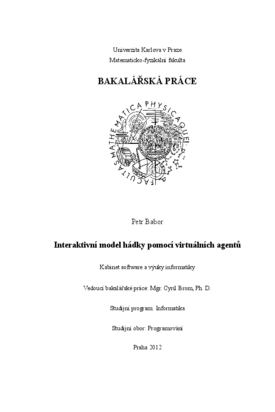Interaktivní model hádky pomocí virtuálních agentů
Three virtual characters in a quarrel: an interactive model
bachelor thesis (DEFENDED)

View/
Permanent link
http://hdl.handle.net/20.500.11956/40304Identifiers
Study Information System: 115285
Collections
- Kvalifikační práce [11266]
Author
Advisor
Referee
Beneš, Jan
Faculty / Institute
Faculty of Mathematics and Physics
Discipline
Programming
Department
Department of Software and Computer Science Education
Date of defense
18. 6. 2012
Publisher
Univerzita Karlova, Matematicko-fyzikální fakultaLanguage
Czech
Grade
Very good
Keywords (Czech)
virtuální agent, konečný automat, improvizační divadloKeywords (English)
virtual agent, finite state machine, improv theaterV počítačových hrách s ambicemi vyprávět příběh se často objevují cut-scény, pasáže hry, kde hráč nehraje, ale pouze sleduje část vyprávěného příběhu. To hráče vyvádí z kontinuity hraní. Je snaha tyto pasáže co nejvíce začlenit do vlastní hry. Cílem práce je navrhnout, implementovat a otestovat model pro tvorbu cut-scén s dynamickým vývojem a omezenou možností uživatelské interakce. Model jsme omezili na situaci, kdy se 3 postavy hádají a implementovali jsme ho pro platformu Pogamut. Jako výrazové prostředky používáme animace a zobrazení emotikon, postavy nemluví přirozeným jazykem. Pohyb zajišťují steeringová pravidla z projektu Steering Library. Dramaturgii a synchronizaci scének řídí pravděpodobnostní konečný automat. Ke zhodnocení práce jsme použili experiment, kde testované osoby sledovaly generované cut-scény a porovnávaly je s ručně vyrobenými. Výsledky potvrdily předpoklad, že generované scénky nedosahují kvality ručně psaných. Testované osoby je přesto vnímaly pozitivně, díky možnosti ovlivňovat jejich vývoj. Implementované části modelu mohou sloužit k tvorbě her a výukových programů se sociální tématikou. Teoretický návrh modelu lze využít i pro jiné platformy.
In computer games, with the ambition to tell a story are often cut-scenes, passages of games, where the player does not play, but only follows a part of the narrated story. This fact distract player from playing. These passages should be integrated as much as possible in the game itself. The goal of our work is to design, implement and test a model for creating cut-scenes with dynamic development and limited user interaction possibilities. We restricted the model to a situation where three characters arguing and we implemented it for the Pogamut platform. We use animations and emoticons as means of expression, characters do not speak by natural language. Movement is ensured by the steering rules from the project Steering Library. Dramaturgy and synchronization of scenes is controlled by a stochastic finite state machine. We made an experiment where the test subjects watched the generated cut-scenes and compared them with hand-made to evaluate the work. The results confirmed the assumption that the quality of generated scenes do not reach handwritten ones. However the test subjects still perceived them positively, because of the ability to influence their development. Implemented parts of the model can be used to create games and educational programs with social theme. Theoretical design of the model can be...
